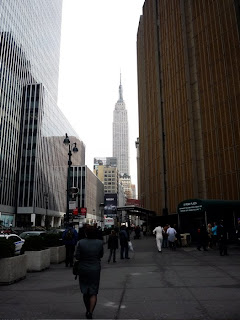More Curiosities from Nooks and Corners of Old New York (1899)
 Continuing with a look at Charles Hemstreet's Nooks and Corners of Old New York, published in 1899, I would like to point out several additional passages of interest.
Continuing with a look at Charles Hemstreet's Nooks and Corners of Old New York, published in 1899, I would like to point out several additional passages of interest.• Many commemorative tablets described in the book are no longer in place. One exception is the plaque honoring William Bradford, the city's first publisher, who set up a printing press at 81 Pearl. His gravestone in Trinity Churchyard is also in good shape. Considering the crisis in the newspaper business and with new reports circulating this week about the imminent demise of The New York Sun, at least we still have Bradford, the original print guy.
 • Hemstreet also directs the reader to the grave of Charlotte Temple in the Trinity Churchyard. Charlotte Temple was the heroine of Susannah Haswell Rowson's novel, Charlotte: A Tale of Truth, published in 1794, and so, by definition, this gravestone slab marks the remains of a fictional character. The sentimental story follows a young woman who falls in love with a dashing British officer and then elopes with him to New York, only to be abandoned after he weds a wealthy woman. She's pregnant, ill and poor, and she dies somewhere near the Bowery on Pell Street. Rowson claimed the story was based on the true story of Charlotte Stanley, a niece of a British nobleman, and that the woman was buried at Trinity. In the 1850s the original grave marker for Stanley disappeared, so the stonecutters made a new slab and chiseled it with the name of Charlotte Temple, not Charlotte Stanley. Some people believe that the original Charlotte Stanley never existed and that the whole thing was a hoax to capitalize on the popularity of the novel. See New York Times story from August 2, 1998 for more info.
• Hemstreet also directs the reader to the grave of Charlotte Temple in the Trinity Churchyard. Charlotte Temple was the heroine of Susannah Haswell Rowson's novel, Charlotte: A Tale of Truth, published in 1794, and so, by definition, this gravestone slab marks the remains of a fictional character. The sentimental story follows a young woman who falls in love with a dashing British officer and then elopes with him to New York, only to be abandoned after he weds a wealthy woman. She's pregnant, ill and poor, and she dies somewhere near the Bowery on Pell Street. Rowson claimed the story was based on the true story of Charlotte Stanley, a niece of a British nobleman, and that the woman was buried at Trinity. In the 1850s the original grave marker for Stanley disappeared, so the stonecutters made a new slab and chiseled it with the name of Charlotte Temple, not Charlotte Stanley. Some people believe that the original Charlotte Stanley never existed and that the whole thing was a hoax to capitalize on the popularity of the novel. See New York Times story from August 2, 1998 for more info. • The Little Church Around the Corner (Episcopal Church of the Transfiguration) on W. 29th Street, became a sanctuary for actors after a nearby church refused to bury a member of the profession. The minister told the famous actor, Joseph Jefferson, who was making the arrangements, that his congregation would object to the presence of such lowlife but he recommended "the little church around the corner."
• The Little Church Around the Corner (Episcopal Church of the Transfiguration) on W. 29th Street, became a sanctuary for actors after a nearby church refused to bury a member of the profession. The minister told the famous actor, Joseph Jefferson, who was making the arrangements, that his congregation would object to the presence of such lowlife but he recommended "the little church around the corner."• The Revolutionary era tavern, the Golden Hill Inn at 122 William St. must have been a pleasure to behold. Hemstreet writes that the inn was much the same as in the old days, but "modern paint has made it hideous to antiquarian eyes."
• Some performing artists held impossibly high aesthetic standards in the New York of the 1830s. Of the company housed at the Olympic Theatre at 444 Broadway, Hemstreet observes, "Little success was met with, the performances being of too artistic nature to be popular..."
 • In addition to the graveyards, murders, and hangings, Hemstreet zeroes in on each and every attempt to drill for water in the city. Among several items of this nature - "A pipe for a well was sunk in Broadway, opposite Bond Street, in April, 1927, it being thought that enough water for the supply of the immediate neighborhood could be obtained therefrom. The water was not found, however." The posh residents of Bond Street of today should take note.
• In addition to the graveyards, murders, and hangings, Hemstreet zeroes in on each and every attempt to drill for water in the city. Among several items of this nature - "A pipe for a well was sunk in Broadway, opposite Bond Street, in April, 1927, it being thought that enough water for the supply of the immediate neighborhood could be obtained therefrom. The water was not found, however." The posh residents of Bond Street of today should take note.See the previous entry for introduction to Nooks and Corners of Old New York here. All images by Walking Off the Big Apple.
See New York 1900: Edith Wharton and The House of Mirth, A Walk and a Map for the several related posts.





Comments
Post a Comment